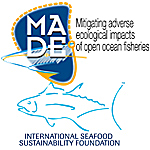This study analyzed the large pelagic species incidentally captured by the Mexican tuna purse-seine fleet during 1998 to 2007. This information was provided by Programa Nacional de Aprovechamiento del Atún y Protección del Delfín (PNAAPD), and covers about 50% of the trips made by this fleet over the study period. Bycatch records were compared among the three different set-types; tuna associated with dolphins, unassociated schools, and tuna associated with floating objects. Floating object sets exhibited significantly higher bycatch rates than the other set types, about 160 times greater than the other set types for the dolphinfish. Using a Generalized Additive Model (GAM) we evaluated the relationship between presence-absence of a particular by-catch species (dolphinfish, wahoo, silky shark, white tip shark, striped marlin, blue marlin, black marlin, and sailfish) and specific environmental variables recorded for each set. The predictor variables used in the model were longitude, latitude, Sea Surface Temperature (SST), chlorophyll-a concentration, Sea Surface Height (SSH), Oceanic Niño Index (ONI), and month. Using the model predictions maps of the probability of capture were created for the different bycatch species. We found that the probability of billfish by-catch (blue marlin, black marlin, striped marlin, and sailfish) was highest in coastal waters, whereas catch rates for dolphinfish, silky shark, and wahoo, were greatest further offshore.
|
|
|
Browse by Author > Ortega-Garcia Sofia
Monday
15
Session 1: BIODIVERSITY & BYCATCH
› 12:10 - 12:30 (20min) › Auditorium
Bycatch recorded by the Mexican tuna purse-seine fleet in the eastern Pacific ocean
1 : INSTITUTO POLITECNICO NACIONAL-CENTRO INTERDISCIPLINARIO DE CIENCIAS MARINAS
(IPN-CICIMAR)
-
Website AV. IPN S/N
COL. PLAYA PALO DE SANTA RITA
LA PAZ BAJA CALIFORNIA SUR
CP 23096 -
Mexico
|
| Online user: 1 | RSS Feed |

|

 PDF version
PDF version